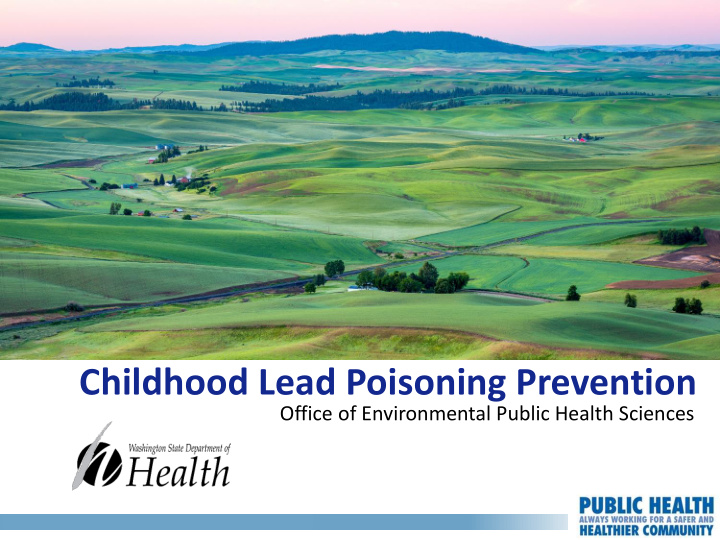



Childhood Lead Poisoning Prevention Office of Environmental Public Health Sciences
Lead • Soft, blue-gray heavy metal • Occurs naturally but much of its presence in the environment stems from historic use in paint and gasoline and from industry • The most widespread source of lead exposure for children is in lead-based paint and dust that remains in older buildings
Children are the most vulnerable Young developing children are much more sensitive to the adverse effects of lead. – Especially harmful to developing brains and nervous systems – Children absorb more of the lead they are exposed to – Young children exhibit more hand-to-mouth behavior, increasing their exposure and intake – Most often there are no symptoms
Lead toxicity Source: Canfield R, et al. NEJM 2003;348:1517-1526
Potential sources of lead exposure
Testing practices across the U.S., 2017 Source: Safer Chemicals, Healthy Families. 2017
History of action levels There is no safe level of lead in blood CDC Lead Action Level 45 In January 2012, the Advisory 40 40 µg/dL Committee on Childhood Lead 35 Poisoning Prevention (ACCLPP) 30 µg/dL 30 recommended: 25 25 µg/dL • Language change from “ level of 20 concern ” to “ reference level” 15 • Reference level set at ≥5 µg/dL* 10 µg/dL 10 CDC adopted recommendation and 5 5 µg/dL WA State changed rules accordingly 0 1971 1975 1985 1991 2012 * Represents the 97.5 percentile from NHANES data
Testing rates by states, 2016 Annual Testing Rate of Children Under 72 Months of Age, 2016 in states reporting annually to CDC 60 50 40 % tested 30 20 10 0 Source: CDC National Childhood Blood Lead Surveillance Data https://www.cdc.gov/nceh/lead/data/national.htm
Blood lead testing rates Blood lead testing rates of children <72 months of age in Washington
Blood lead testing rates Blood lead testing rates by county (2014-2018)
Elevated blood lead levels
Elevated blood lead level rates Elevated blood lead level rates by county (2014-2018 ) Elevated is defined as ≥5µg/ dL
Distribution of the percent of cases ≥5 µg/dL assigned to Local Health Jurisdictions in a 10 year period (2006- 2015) Snohomish 3.25% Spokane King 5.6% 33.0% Grant Pierce Adams 4.0% Whitman 7.5% 3.4% 4.7% Franklin Yakima 3.2% 6.5% Cowlitz 4.0%
Prevention: Keep it clean and maintained • Damp dust and change water frequently • Inspect home regularly and fix chipping, flaking, peeling and deteriorated paint using lead-safe work practices • Remove shoes before entering the house • Take care of minor problems before they become major
Prevention: Healthy diet • Eat regular meals • Eat foods rich in iron, calcium and vitamin C
Resources Clinical screening algorithm http ://www.doh.wa.gov/Portals/1/Documents/Pubs/334 -394.pdf WA lead exposure risk map https ://fortress.wa.gov/doh/wtn/WTNIBL/ PEHSU medical management guidelines http://www.pehsu.net/_Childhood_Lead_Exposure.html DOH lead website www.doh.wa.gov/lead
Elisabeth Long, MPH Lenford O’Garro, MS, RS Office of Environmental Public Health Sciences Washington State Department of Health elisabeth.long@doh.wa.gov lenford.o’garro@doh.wa.gov www.doh.wa.gov/lead
Recommend
More recommend